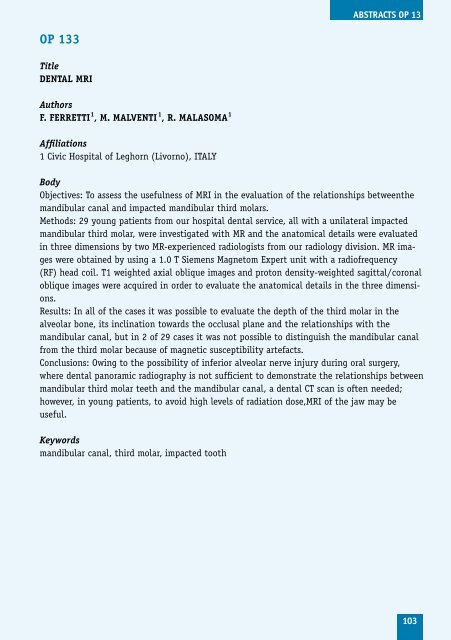Program including abstracts as pdf available here
Program including abstracts as pdf available here
Program including abstracts as pdf available here
Create successful ePaper yourself
Turn your PDF publications into a flip-book with our unique Google optimized e-Paper software.
OP 133<br />
Title<br />
DENTAL MRI<br />
Authors<br />
F. FERRETTI 1 , M. MALVENTI 1 , R. MALASOMA 1<br />
Affiliations<br />
1 Civic Hospital of Leghorn (Livorno), ITALY<br />
aBSTracTS OP 13<br />
Body<br />
Objectives: To <strong>as</strong>sess the usefulness of MRI in the evaluation of the relationships betweenthe<br />
mandibular canal and impacted mandibular third molars.<br />
Methods: 29 young patients from our hospital dental service, all with a unilateral impacted<br />
mandibular third molar, were investigated with MR and the anatomical details were evaluated<br />
in three dimensions by two MR-experienced radiologists from our radiology division. MR images<br />
were obtained by using a 1.0 T Siemens Magnetom Expert unit with a radiofrequency<br />
(RF) head coil. T1 weighted axial oblique images and proton density-weighted sagittal/coronal<br />
oblique images were acquired in order to evaluate the anatomical details in the three dimensions.<br />
Results: In all of the c<strong>as</strong>es it w<strong>as</strong> possible to evaluate the depth of the third molar in the<br />
alveolar bone, its inclination towards the occlusal plane and the relationships with the<br />
mandibular canal, but in 2 of 29 c<strong>as</strong>es it w<strong>as</strong> not possible to distinguish the mandibular canal<br />
from the third molar because of magnetic susceptibility artefacts.<br />
Conclusions: Owing to the possibility of inferior alveolar nerve injury during oral surgery,<br />
w<strong>here</strong> dental panoramic radiography is not sufficient to demonstrate the relationships between<br />
mandibular third molar teeth and the mandibular canal, a dental CT scan is often needed;<br />
however, in young patients, to avoid high levels of radiation dose,MRI of the jaw may be<br />
useful.<br />
Keywords<br />
mandibular canal, third molar, impacted tooth<br />
103


